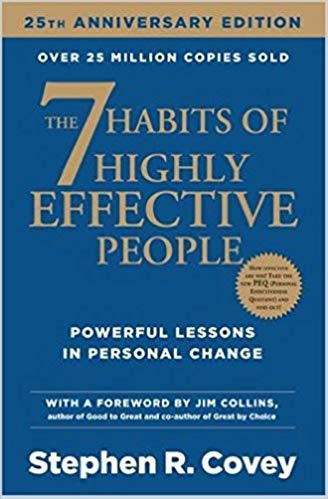

This article is an excerpt from the Shortform summary of "The 7 Habits of Highly Effective People" by Stephen Covey. Shortform has the world's best summaries of books you should be reading.
Like this article? Sign up for a free trial here .
What is Habit 3: put first things first of the 7 habits? What are the tools you can use to achieve it?
Habit 3, “put first things first,” discusses self-management, leading the effort on the ground to hack your way through the underbrush and reach your destination. Habit 3 encourages you to use time management and emotional awareness to work toward finding what’s important to you and following through.
What is Habit 3: Put First Things First?
While Habit 1 empowers you to create your own paradigms, and Habit 2 explains how to translate that paradigm into a principle-centered mission statement to direct your life — the first creation — Habit 3: Put First Things First explores how to translate that into day-to-day choices, the second creation.
We mentioned the four unique human endowments in Habit 1: self-awareness, conscience, imagination, and independent will. You used self-awareness to take notice of your paradigms, your conscience to decide how you want to change or improve them, and your imagination to develop new paradigms. Habit 3 exercises your independent will, that powerful ability to be proactive and decide how you act rather than simply reacting to external forces.
Time Management Matrix: The Four Generations
In order to use your independent will to effectively achieve mission statement and ultimate goals, you need the proper tools of time management. Over time, four generations of time management techniques have emerged, and can serve as put first things first examples.
- First Generation: Notes and Checklist The first iteration of time management tools focuses on gathering all the varied tasks and to-dos into checklists and Post-It notes.
- Second Generation: Calendars and Planners The second generation of time management takes things a step further by taking all the to-dos on your checklists and organizing them into a schedule.
- Third Generation: Goal Setting and Daily Planning The third generation builds on the second generation’s scheduling techniques by adding prioritization through clarifying your values and setting long- and short-term goals.
- Fourth Generation: Self Management, Not Time Management he fourth generation is about managing yourself so that you can actively decide which tasks will have the most value in your life and adjust accordingly as things come up.
Habit 3: Put First Things First- What is Quadrant II?
Quadrant II is about dedicating your time and energy to what’s truly important. This will help you use habit 3, put first things first, of the 7 habits.
All tasks can be categorized based on their urgency and importance: An activity can be one (either urgent or important), both, or neither. We react to urgent matters, while important tasks that are not urgent require us to be proactive. The quadrants can help us see put first things first examples in real life. See the chart below for an explanation of the quadrants.
| Urgent | Not Urgent | |
| Important | Quadrant I: Urgent and Important | Quadrant II: Not Urgent, but Important |
| Not Important | Quadrant III: Urgent but Not Important | Quadrant IV: Neither Urgent nor Important |
Shifting From Quadrant I to Quadrant II
In a put first things first example, Covey asked several shopping center managers what one thing could they could do that would improve their businesses. They all responded that building better relationships with their tenants — the store owners in their shopping centers — would have a tremendous impact. However, they were all busy with other things like meetings, or dealing with problems that came up throughout the day. By doing this, they were not practicing habit 3: put first things first.
Quadrant I was eating up so much of the managers’ time, they hardly had any left for the Quadrant II relationship-building that they felt would greatly benefit them.
The shopping center managers decided to take a proactive step and dedicate significantly more time to building relationships with tenants, which yielded impressive results.
Learning to Say No in Habit 3: Put First Things First
When you begin shifting your attention to Quadrant II, at first you’ll only be able to take time from the unimportant Quadrant III and IV activities. You’ll still need to attend to the urgent and important tasks in Quadrant I, but those will gradually shrink as you put more effort into Quadrant II preventive activities. If you want to make time for Quadrant II priorities, you’ll have to say “no” to unimportant tasks — even when they appear urgent.
Keeping your focus on Quadrant II is a paradigm that you can develop from a principle center; having a clear sense of your mission, principles, and values, will make it easier to say “no” to the unimportant because you’ll know you’re making room for the important.
Creating a Quadrant II Paradigm
Like any paradigm shift, developing a Quadrant II paradigm will take time, practice, and deliberate effort. Start by planning out one week according to the Quadrant II-focused, fourth-generation method.
- Step 1: What Are Your Roles? Just as you did for your personal mission statement, identify the various roles you have in the personal, professional, and leisure areas of your life; this will help you keep your focus and priorities balanced and avoid neglecting any particular area of your life and responsibilities. In this exercise, only focus on roles that are applicable for the next week. In addition to your role as an individual, list one or more roles you have in your family, your work life, and one more role in your community.
- Step 2: Set Goals Think about one or two important results you’d like to achieve for each role within the next week. These goals should contribute to the longer-term, big-picture goals in your personal mission statement, and at least some of them should fall into Quadrant II.
- Step 3: Schedule Your Goals Now that you have a list of goals to accomplish in the next week, start scheduling them. Some goals might be time-sensitive, or only doable during business or weekend hours; with this in mind, assign a day (or take it a step further and create an appointment time) to achieve each goal.
- Step 4: Adapt as Needed As you move through your week, begin each day by reviewing what’s on that day’s agenda and remembering why these activities are important for your overall goals. When things come up unexpectedly, address them according to your goals and scheduled priorities. Third generation-style daily planning can help you make order of your day, and it will be a more effective use of the method when it’s in the context of your weekly schedule.
Delegation: The Key to Effectiveness
How do you make sure you have time for your high-priority, Quadrant II goals, while also leaving room in your schedule for the unexpected? Delegate.
Some people resist delegating tasks to other people because of the up-front time investment. However, this will help you practice habit 3: put first things first in the long run. You have to explain what needs to be done and how to do it, and the other person might not do as good a job as you could’ve done.
But delegating tasks that can be performed by someone else is the essence of a Quadrant II activity: instead of reacting to the urgent need to just get a task done, you’re making a short-term investment that frees you up in the long term to spend your time and energy on more important and valuable activities.
There are two forms of delegation: gofer delegation, and stewardship delegation. One is far superior than the other.
Gofer Delegation
The first is gofer delegation — when a manager simply instructs her team members to “go for this, go for that.” Gofer delegation is not very effective because the manager is essentially micromanaging her team, focusing on the methods they use rather than the results they achieve. In addition, gofer delegation doesn’t free up the manager to attend to other tasks if she is busy supervising every action her team takes. Plus, her hovering doesn’t give her team members space to develop any personal investment in the results.
Stewardship Delegation
The second approach in the example above is stewardship delegation. Stewardship delegation focuses on the results instead of the methods, giving team members the freedom to choose their approach and have a greater stake in the results. This requires managers to trust their employees, and to allow time for employees’ learning curve to reach that level of trust.
In order to practice habit 3, put first things first you need to practice effective stewardship delegation. It requires managers to clearly communicate her expectations in five areas:
- Results: The team member must understand what results she is responsible for accomplishing.
- Guidelines: While the manger shouldn’t dictate the methods for accomplishing a goal, it’s important that she explain the parameters so the team member doesn’t unknowingly violate rules or standard operating procedures.
- Resources: Team members need to understand what resources are available to help them accomplish the task, whether that includes manpower, money, technology, or support from the organization.
- Accountability: Managers must explain the quality standards that will be used to measure the results, and when results will be evaluated.
- Consequences: Team members need a clear understanding of the consequences of success — such as a financial bonus or job promotion — and of failure.
When using stewardship delegation, adapt your approach to the person and situation.
Working with Others to Achieve Your Goals
You can’t reach interdependence before achieving true independence; this is why the first three habits focus on tapping into your self-awareness and honing your self-control and self-discipline. Only once you have a clear understanding of your paradigms, principles, and goals can you effectively build relationships with other people.
And it’s worth the effort: Human relationships provide enriching and meaningful experiences, greatly improve your productivity, and help you learn and grow.
But human relationships can also be difficult, and cause pain and frustration. It’s important to remember that the acute pain you feel from interpersonal problems always stems from a chronic, underlying problem, so when you attempt to resolve the issue you must address the root, not the symptom. These relationships are an essential part of habit 3: put first things first.
Remember, in a relationship, every problem that arises is actually an opportunity to empower and deepen that relationship. In this way, any problem with P (the emotional, organizational, or other benefits that the relationship brings each person) is a chance to build PC (the healthy relationship that fosters P).
This is also a critical concept in business: When a customer comes in with a problem or complaint, don’t be resentful or defensive. Instead, show a genuine desire to resolve the issue and go the extra mile in treating the customer well and providing excellent service.
Your Emotional Bank Account
Every relationship comes with an Emotional Bank Account that stores the trust between two people. In your interactions, you make deposits with acts of kindness and love, and withdrawals in your acts of meanness or betrayal.
An Emotional Bank Account is as active as the relationship. If you see someone constantly — like a spouse or close friend — you must make consistent deposits with acts of kindness and respect, because there may be automatic withdrawals in your regular interactions (like your chronic lateness), some of which you might not even realize are withdrawing from the account.
It’s possible to build up a positive trust balance in a low or overdrawn Emotional Bank Account, but it takes time. There are six things you can do to make substantial deposits.
- Make an effort to understand the other person, and do things that are important to them. You must understand what’s important to the other person, and by virtue of you caring about that person, that makes it important to you.
- Don’t underestimate the power of small actions. Small acts of kindness and caring can speak volumes and make large deposits into your Emotional Bank Account. Similarly, small acts of disrespect and discourtesy can make large withdrawals.
- Keep your promises. Don’t make commitments and promises lightly, because while keeping true to them makes big deposits, breaking them makes huge withdrawals.
- Love unconditionally. When you love someone unconditionally, you add to their sense of security and validation and they are empowered to live to their fullest capacity, with cooperation, self-discipline, integrity, and independence.
By understanding habit 3: put first things first of the 7 habits, you are developing self-awareness and actionable goals alongside what you learned in the first two habits. Habit 3, put first things first, will enable you to have a clear mind and a set of tools for managing your self, your life, and your relationships.
———End of Preview———

Like what you just read? Read the rest of the world's best summary of "The 7 Habits of Highly Effective People" at Shortform . Learn the book's critical concepts in 20 minutes or less .
Here's what you'll find in our full The 7 Habits of Highly Effective People summary :
- How to prioritize the hundred tasks you have to focus on the one or two that really matter
- The right way to resolve every disagreement and argument
- How to avoid burning out and succeed over 20+ years






